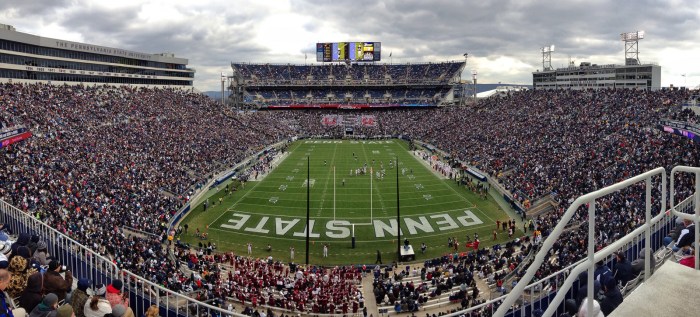Step into the hallowed grounds of Beaver Stadium, where the echoes of countless football battles reverberate through time. A symbol of Penn State University’s unwavering spirit and sporting legacy, this architectural marvel stands as a testament to the indomitable passion that fuels college football.
From its humble beginnings to its modern-day grandeur, Beaver Stadium has witnessed a rich tapestry of moments that have shaped the fabric of Penn State’s identity. Prepare to embark on a captivating journey through the history, atmosphere, and impact of this legendary venue.
Stadium History and Development

Beaver Stadium, located in University Park, Pennsylvania, is the home of the Penn State Nittany Lions football team. The stadium has a rich history dating back to its construction in 1960. Over the years, Beaver Stadium has undergone several renovations and expansions, transforming it into one of the most iconic college football stadiums in the nation.
The initial construction of Beaver Stadium began in 1959 and was completed in 1960. The stadium’s original capacity was 33,500, but it has since been expanded several times. In 1966, the stadium’s capacity was increased to 46,284. In 1982, the stadium underwent a major renovation that added 15,000 seats, bringing the capacity to 61,284. The stadium’s most recent expansion occurred in 2001, when the capacity was increased to 107,282, making it the second-largest college football stadium in the United States.
Beaver Stadium is known for its unique architectural features and design elements. The stadium’s horseshoe-shaped design provides excellent sightlines for fans, and the massive end zones create an intimidating atmosphere for opposing teams. The stadium’s exterior is made of limestone and brick, giving it a classic and timeless look.
Beaver Stadium has had a significant impact on the surrounding community and Penn State University. The stadium is a major tourist attraction, and it generates millions of dollars in revenue for the local economy. The stadium also plays a vital role in the university’s athletic program, and it has helped to make Penn State one of the most successful college football programs in the nation.
Stadium’s Architectural Features
- Horseshoe-shaped design for optimal sightlines
- Massive end zones for an intimidating atmosphere
- Limestone and brick exterior for a classic look
Stadium’s Impact on the Community and Penn State University
- Major tourist attraction generating revenue for the local economy
- Vital role in Penn State’s athletic program and its success in college football
Game Day Atmosphere
Penn State football games at Beaver Stadium are renowned for their electric atmosphere and passionate fan base. The stadium transforms into a sea of blue and white, creating an unforgettable game day experience.
The student section, known as “The White Out,” is a driving force behind the stadium’s unparalleled energy. Dressed in all white, these dedicated students create a deafening roar that reverberates throughout the stadium. Their enthusiasm is infectious, and it sets the tone for the entire game.
Fan Rituals
In addition to “The White Out,” Beaver Stadium is home to several other fan rituals that contribute to the game day atmosphere. These include:
- The “Lion Walk,” where the Penn State football team walks through a tunnel of cheering fans before the game.
- The singing of the Penn State Alma Mater, “Hail to the Lion,” after every game.
- The “Swoosh,” a coordinated wave performed by the crowd after every touchdown.
Acoustics
The acoustics of Beaver Stadium play a significant role in enhancing the game day experience. The stadium’s horseshoe shape and steep seating create an amplified sound environment that makes the crowd noise deafening. This creates a sense of intimacy and excitement, making fans feel like they are right on top of the action.
Stadium Facilities and Amenities

Beaver Stadium boasts an array of facilities and amenities that enhance the game day experience for fans. With a seating capacity of over 106,000, it ranks among the largest stadiums in the country. Premium seating options, including suites, club seats, and loge boxes, offer elevated amenities and exclusive access.
The stadium is equipped with state-of-the-art technological advancements. A massive video board, measuring 32 feet high by 105 feet wide, provides crystal-clear replays and live action. A cutting-edge sound system delivers immersive audio, creating an electrifying atmosphere.
Food and Beverage Options
Beaver Stadium offers a wide selection of food and beverage options to cater to fans’ appetites. Concourses are lined with concession stands serving a variety of classic stadium fare, including hot dogs, hamburgers, pizza, and nachos. Additionally, there are specialty stands offering local delicacies, vegetarian options, and gourmet snacks.
Merchandise Stands and Other Amenities
Fans can purchase official Penn State merchandise at numerous stands located throughout the stadium. These stands offer a wide range of apparel, souvenirs, and memorabilia. Other amenities include ATMs, first aid stations, and charging stations for electronic devices.
Economic Impact

Beaver Stadium is a major economic driver for the local economy, generating significant revenue for Penn State University, local businesses, and the surrounding community.
The stadium’s impact extends far beyond game days, with its presence attracting visitors, creating jobs, and stimulating economic activity throughout the year.
Revenue for Penn State University
- Ticket sales: Beaver Stadium is one of the largest college football stadiums in the country, with a capacity of over 106,000. Ticket sales generate millions of dollars in revenue for Penn State University, which supports athletic programs and other university initiatives.
- Concessions and merchandise: The stadium’s concessions and merchandise stands generate additional revenue, contributing to the university’s overall income.
- Donations and sponsorships: Beaver Stadium’s prominence and popularity attract donations and sponsorships from businesses and individuals, further bolstering Penn State University’s financial resources.
Sustainability and Environmental Impact
Beaver Stadium is committed to sustainability and reducing its environmental footprint. The stadium has implemented several initiatives to achieve this goal.
Renewable Energy Sources
Beaver Stadium uses renewable energy sources to power its operations. The stadium has installed solar panels that generate electricity from the sun. The stadium also purchases renewable energy credits from wind and solar farms.
Waste Reduction Programs
Beaver Stadium has implemented waste reduction programs to reduce the amount of waste sent to landfills. The stadium has recycling bins for paper, plastic, and metal. The stadium also composts food waste.
Water Conservation Measures
Beaver Stadium has implemented water conservation measures to reduce its water usage. The stadium has installed low-flow toilets and faucets. The stadium also uses rainwater harvesting systems to collect and reuse rainwater.
Environmental Awareness and Education
Beaver Stadium promotes environmental awareness and education through its sustainability initiatives. The stadium has educational displays about sustainability. The stadium also hosts events and programs that promote environmental awareness.
Frequently Asked Questions
When was Beaver Stadium built?
Construction on Beaver Stadium began in 1960, and it officially opened in 1961.
What is the seating capacity of Beaver Stadium?
Beaver Stadium has a seating capacity of 106,572, making it the second-largest on-campus stadium in the United States.
What is the “White Out”?
The “White Out” is a tradition at Penn State football games where fans wear white clothing to create a sea of white in the stands. It is considered one of the most iconic and intimidating atmospheres in college football.




